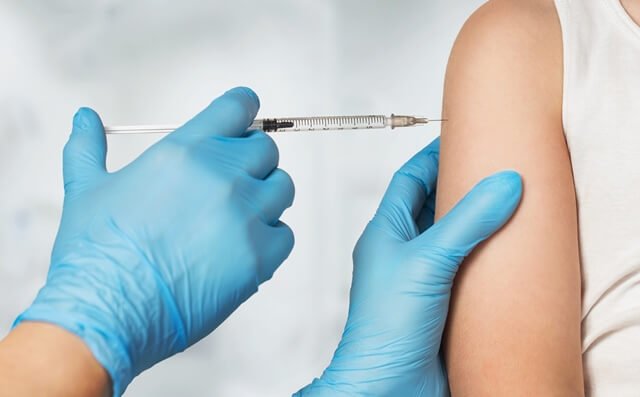Vaccination can help protect us from deadly diseases caused by viruses. They work by boosting the immune system’s ability to fight specific infections. It makes the immune system recognize and fight specific germs so that when they are exposed to them in the future, the person will have a much lower risk of getting sick
Immunity
When disease bacteria enter a body, they start to reproduce. Our immune system recognizes these bacteria as foreign invaders. It starts producing antibodies. These antibodies help in destroying the bacteria that make a person sick. They may not act fast enough to prevent from becoming sick, but by defeating the attacking bacteria, antibodies help to get well.
The antibodies protect from future infections. They remain in the bloodstream, and if the same bacteria try to invade, they defend the body. Even after many years. Now they can destroy the bacteria before they have a chance to make you sick. This is immunity. For example, most people get diseases like chickenpox only once, even though they might be exposed many times during their lifetime.
The immune system
When bacteria or viruses, attack the body, they invade and multiply. This invasion is an infection. Which causes an illness. The immune system uses several agents to fight infection. Blood has Red blood cells (erythrocytes) and white blood cells (leukocytes). Red blood cells carry oxygen to tissues and organs. White blood cells fight with infection. These white cells consist fundamentally of macrophages, B-lymphocytes, and T-lymphocytes:
• Macrophages: These are white blood cells that consume and absorb germs, dead, or dying cells. The macrophages leave behind bits of the invading germs called antigens. The body recognizes antigens as threatening and stimulates antibodies to attack them.
• B-lymphocytes: These are defending white blood cells. They generate antibodies that attack the antigens left behind by the macrophages.
• T-lymphocytes: These are different types of defensive white blood cells. They attack cells in the body that have already been contaminated. The first time the body encounters a germ, it takes several days to make and use all the germ-fighting agents needed to get over the infection. After the infection, the immune system remembers what it learned about how to defend the body against that disease.
The body keeps a few T-lymphocytes, called memory cells, that go into action immediately if the body finds the same germ again. B-lymphocytes produce antibodies to attack when similar antigens are detected.
How Vaccination Work
Vaccines prevent diseases that can be life-threatening. They considerably lessen the risk of infection by working with the body’s natural defenses to cautiously develop immunity to disease. Sometimes, after getting a vaccine, replicate infection can cause minor symptoms, such as fever. Such symptoms are common and should be expected as the body builds immunity. Vaccines help improve immunity by simulating an infection. This type of infection, however, rarely causes illness, but it does cause the immune system to produce T-lymphocytes and antibodies. Once the infection goes away, the body is left with a supply of t-lymphocytes and B-lymphocytes that will remember how to fight that disease in the future. However, it typically takes time for the body to produce T-lymphocytes and B-lymphocytes after vaccination. Therefore, one could develop symptoms and get a disease because the vaccine has not had enough time to provide protection.
Vaccines Require More Than One Dose
• Primarily inactivated vaccines: For some vaccines, the first dose does not provide as much immunity as possible. So, more than one dose is needed to build more complete immunization. For example, the vaccine that protects against the bacteria Hib, which causes meningitis.
• Booster: For some vaccines, immunity begins to wear off after some time. A booster dose is required to bring immunity levels to normal. This booster dose usually happens several years after the first vaccine doses are given. In the DTaP vaccine, children receive an initial series of four shots that protect against tetanus as part of their infant immunizations which helps build immunity. Then a booster dose is given at after 4 years through 6 years old. Another booster against these diseases is given at 11 years or 12 years of age.
• Primarily live vaccines: For some vaccines, More than one dose is needed for everyone to develop the best immune response. For instance, after one dose of the MMR vaccine which protects against measles, some people may not develop enough antibodies to fight off infection. The second dose guarantees that nearly everyone is guarded.
• Flu vaccines: In the case of flu vaccines, adults and children require to get a dose every year. Children from 6 months to 8 years old who have never gotten a flu vaccine earlier or have only gotten one dose in past years need two doses the first year they are vaccinated. Then, an yearly flu vaccine is needed because the flu viruses causing disease may vary from season to season. Every year, flu vaccines are made to guard against the viruses that research suggests will be most obvious. Also, the immunity a child gets from a flu vaccination fades off over time. Getting a flu vaccine every year helps keep a child protected.
Common misconceptions
Vaccination does not cause autism
There is no link between a vaccine and the possibility of developing autism. Research shows that infants may be born with autism before any vaccinations are given.
Vaccination is not too much for an infant’s immune system
Infants’ immune systems can handle much more than what vaccines give them. They are exposed to numbers of bacteria and viruses every day. Adding a few more with a vaccine doesn’t add to what their immune systems are capable of handling.
Vaccination does not contain toxins
Some vaccines contain trace quantities of substances that could be harmful in a large dose. These include formaldehyde, aluminum, and mercury. But the amount used in the vaccines is so little that they are absolutely safe.
Vaccination does not cause the diseases they are meant to stop
This is a common misconception. Many people will think they got sick after a vaccine shot. But vaccines contain dead viruses so t’s impossible to get sick from the shot. Even with vaccines that use weakened live viruses, one could experience mild symptoms similar to the illness. But won’t have the disease.
We still need vaccines, even though infection rates are low
Many diseases are uncommon in several countries because of the high vaccination rate. But there are still many countries which have it. If a traveler from an infected country brings disease to the un-infected, anyone who isn’t vaccinated is at risk of getting that disease. The only way to keep the infection rate level low is to continue vaccinating.







